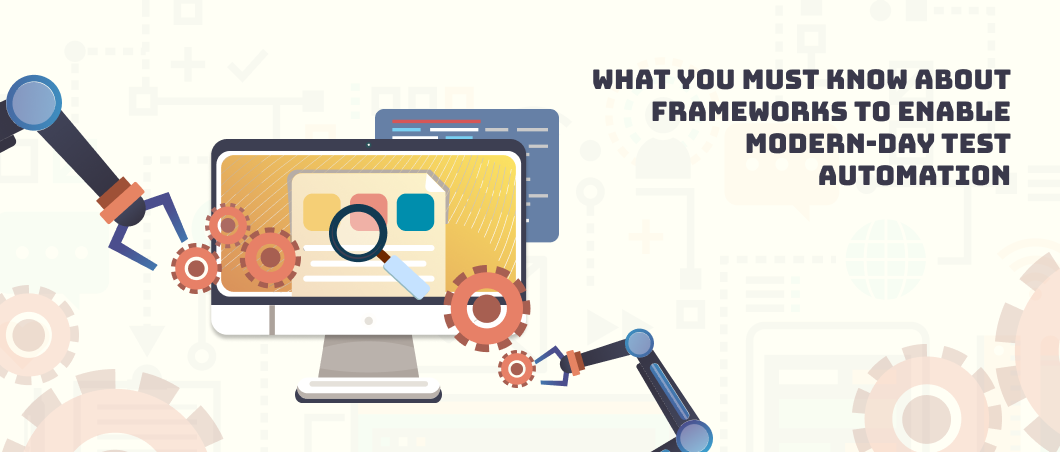There is little doubt about the overwhelming importance of software testing in this age of digital applications. With the rapid evolution of the faster and more iterative Agile and DevOps methodologies, software companies are also seeking faster and more efficient modes of testing – as a replacement to the traditional testing methods.
This shift is what has sharply accelerated the move to embed automated testing (or what is also called test automation) across every part of the software development process. As organizations look to draw evermore out of their test automation strategies, the focus is once again shifting to how proper test automation frameworks can play a crucial role.
How do test automation frameworks overcome the modern-day challenges of test automation – and which are the different types of frameworks? Here is the complete story.
Challenges of Modern-Day Test Automation
While test automation can speed up software validation, it does have its share of challenges in a world of accelerated development, cross-functional teams, and manic releases. These include:
- Communicating the objectives of test automation effectively to “testing” team members
- Selecting the right set of automation tools – and finding the right resource to execute the tools
- Hiring skilled resources with industry experience in designing and implementing the strategic approaches to test automation
- Deciding on the “best fit” approach to test automation
- Managing the upfront cost of setting up the right test automation approach
- Measuring and managing the ongoing progress of the test automation against the desired objectives
How can the right test automation framework help in overcoming these challenges and enable next-gen test automation?
How do Automation frameworks enable Test Automation?
Let’s start with the basics. An automation framework improves the testing accuracy, as well as the efficiency and productivity of your software testing team. Additionally, it can reduce the cost of software testing along with maintenance costs.
A test automation framework is not a single testing tool but is a collection of various pre-built conditions, tools, and methodologies that work together to deliver automated testing for a specific set of test cases or scenarios. Here are some of the benefits of using an automation framework for your testing purposes:
- It enables a standardized test script and code that can be reused by different team members
- It facilitates the continuous testing of application code, which is suited to the modern DevOps methodology
- It reduces the organization’s dependence on individual resource skills and introduces consistency across the testing process.
- It enables faster bug detection and resolution – along with accurate root-cause analysis of the problem
So, for the team building the software, how do you write a test automation framework? Essentially, a framework must fulfill the following goals:
- Use the correct abstraction layers that can quickly create frameworks.
- Have the right framework logging and reporting structure.
- Should be easy to maintain and extend.
- Simple for software testers to write automated test scripts.
- Ability to re-execute failed tests through a retry mechanism.
Let us look at 6 types of test automation frameworks that are commonly used in automated testing.
What are the different types of test automation frameworks?
- Linear Scripting (or automation) framework
Also referred to as the “Record & Playback model,” linear scripting is an introductory framework where testers create and run the testing scripts sequentially. This framework works in an incremental mode, where new interactions are added to the automation tests.
Pros of linear scripting:
- Ideal for smaller applications
- Requires limited knowledge of test automation
- No requirement to write custom code
Cons of linear scripting:
- Limited flexibility and reusability as the hardcoded test cases cannot be re-run in multiple use cases
- High on maintenance
- Modular testing framework
Module-based test frameworks primarily divide all the test cases into smaller modules that can be tested independently. Thus, all testing scripts are developed for each module. It uses the concept of “abstraction layer,” where modular changes in one part of the application do not impact the other modules.
Pros of modular testing:
- Easier maintenance and scalability
- Independent testing of individual modules
- Time-efficient testing with lower efforts
Cons of modular testing:
- Analyzing test cases consumes more time
- Need to identify reusable components
- Behavior-driven testing framework
The behavior-driven testing (or BDT) framework is designed to test an application based on user behavior instead of software functions. The BDT framework uses easy-to-understand language that allows even non-technical resources (for example, business analysts, product managers) to participate in the testing process in some ways.
Pros of BDT framework:
- Use of natural and non-technical language in test specifications
- Improves collaboration between testers and developers in the project
- Suitable for understanding product and business requirements
Cons of BDT framework:
- Requires prior experience in testing-driven development
- Data-driven testing framework
A data-driven testing framework separates the testing data from the testing scripts and stores it externally. This framework creates different test automation scripts and passes various datasets through them. Thus, a single testing script can execute different testing use cases with multiple datasets. The overall aim of the data-driven testing framework is to create reusable scripts that can work for testing different datasets.
Pros of data-driven testing:
- Reduces the number of automation testing scripts
- Allows reusability of testing scripts
- Faster testing process
Cons of data-driven testing:
- Requires advanced testing knowledge
- The initial setup of the framework is time-consuming and costly
- The availability of data becomes a crucial point of failure for the whole strategy
- Keyword-driven testing framework
Developed as an extension to the data-driven testing framework, the keyword-driven testing framework essentially uses data tables and keywords to drive actions on the tested application. The automation testing scripts are executed based on keywords specified in Excel project files. To enable reusability, software testers can use the same keywords in different testing scripts.
Pros of keyword-driven testing:
- Reusability of keywords across testing scripts
- Easier to scale and lower maintenance
Cons of keyword-driven testing:
- Suitable only for small web applications.
- The initial setup of the framework is time-consuming and costly.
- Hybrid testing framework
This framework combines the capabilities of modular, data-driven, and keyword-driven frameworks. This allows it to mitigate the limitations of the individual frameworks, as well as harness their benefits.
Pros of hybrid testing:
- The flexibility of using various automation frameworks
- Improves testing efficiency
Cons of hybrid testing:
- Requires the development of full testing scripts
Conclusion
Automation testing frameworks are now the accepted way forward to enable flexible and fast application testing. These testing frameworks are designed to improve product quality and speed up the testing process.
So, which of the automation frameworks discussed in this article is right for your organization? With the experience of hundreds of releases, Forgeahead can help build reusable automation frameworks that are right for your product strategy. We provide quality assurance services much more than just software testing. Get a free project estimate from us today to know more.
FAQ
Why is a test automation framework important?
A test automation framework is important because it standardizes the way tests are written and executed, reducing redundancy and improving consistency. It enables teams to manage test cases systematically, facilitates better reporting, and ensures that tests are reusable and maintainable. By streamlining the testing process, it helps in identifying defects early, reducing the time and cost associated with manual testing.
How do you choose the right test automation framework?
Choosing the right test automation framework depends on several factors, including the complexity of the application under test, the team’s skill set, the types of tests to be automated, and the tools available. It’s important to evaluate the framework’s compatibility with the application, ease of maintenance, scalability, and integration capabilities with other tools. Conducting a proof of concept (PoC) with a few frameworks can help in making an informed decision.
What are the types of test automation frameworks?
There are several types of test automation frameworks, including:
- Linear (Record and Playback): Scripts are recorded and played back without any modifications.
- Modular Testing Framework: Tests are broken down into small, independent scripts or modules.
- Data-Driven Framework: Test data is separated from test scripts, allowing tests to be run with different data sets.
- Keyword-Driven Framework: Uses keywords to represent actions, making tests more readable and reusable.
- Hybrid Framework: Combines features of multiple frameworks to leverage their advantages.
What are the challenges in implementing a test automation framework?
Implementing a test automation framework can be challenging due to initial setup costs, the need for skilled resources, and the time required to develop and maintain test scripts. Integrating the framework with existing tools and processes, ensuring compatibility with various environments, and managing test data can also be complex. Additionally, ensuring that the framework remains flexible and scalable to accommodate future changes in the application can be difficult.
How do you maintain a test automation framework?
Maintaining a test automation framework involves regularly updating test scripts to accommodate changes in the application under test, refactoring code to improve efficiency and readability, and ensuring that test data is current and relevant. It’s also important to monitor test execution results, address any failures promptly, and update the framework to integrate with new tools or technologies. Regular reviews and updates help in keeping the framework robust and effective.



